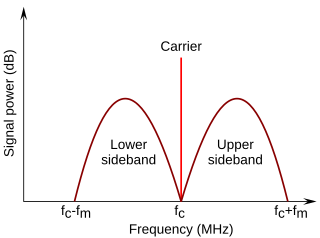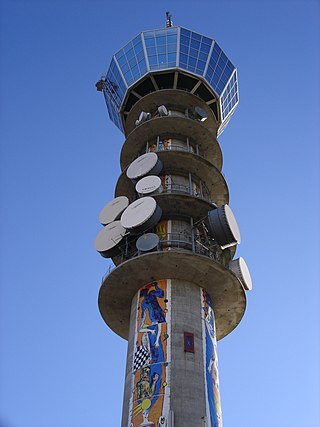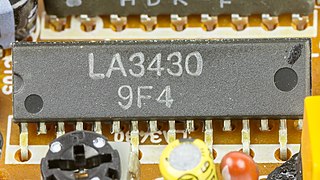
The first American standard for analog television broadcast was developed by the National Television System Committee (NTSC) in 1941. In 1961, it was assigned the designation System M.

In radio communications, a sideband is a band of frequencies higher than or lower than the carrier frequency, that are the result of the modulation process. The sidebands carry the information transmitted by the radio signal. The sidebands comprise all the spectral components of the modulated signal except the carrier. The signal components above the carrier frequency constitute the upper sideband (USB), and those below the carrier frequency constitute the lower sideband (LSB). All forms of modulation produce sidebands.

In telecommunications, frequency-division multiplexing (FDM) is a technique by which the total bandwidth available in a communication medium is divided into a series of non-overlapping frequency bands, each of which is used to carry a separate signal. This allows a single transmission medium such as a microwave radio link, cable or optical fiber to be shared by multiple independent signals. Another use is to carry separate serial bits or segments of a higher rate signal in parallel.

Radio broadcasting is the broadcasting of audio (sound), sometimes with related metadata, by radio waves to radio receivers belonging to a public audience. In terrestrial radio broadcasting the radio waves are broadcast by a land-based radio station, while in satellite radio the radio waves are broadcast by a satellite in Earth orbit. To receive the content the listener must have a broadcast radio receiver (radio). Stations are often affiliated with a radio network that provides content in a common radio format, either in broadcast syndication or simulcast, or both. Radio stations broadcast with several different types of modulation: AM radio stations transmit in AM, FM radio stations transmit in FM, which are older analog audio standards, while newer digital radio stations transmit in several digital audio standards: DAB, HD radio, DRM. Television broadcasting is a separate service that also uses radio frequencies to broadcast television (video) signals.

Quadraphonic sound – equivalent to what is now called 4.0 surround sound – uses four audio channels in which speakers are positioned at the four corners of a listening space. The system allows for the reproduction of sound signals that are independent of one another.
A subcarrier is a sideband of a radio frequency carrier wave, which is modulated to send additional information. Examples include the provision of colour in a black and white television system or the provision of stereo in a monophonic radio broadcast. There is no physical difference between a carrier and a subcarrier; the "sub" implies that it has been derived from a carrier, which has been amplitude modulated by a steady signal and has a constant frequency relation to it.
C-QUAM is the method of AM stereo broadcasting used in Canada, the United States and most other countries. It was invented in 1977 by Norman Parker, Francis Hilbert, and Yoshio Sakaie, and published in an IEEE journal.
Second audio program (SAP), also known as secondary audio programming, is an auxiliary audio channel for analog television that can be broadcast or transmitted both over-the-air and by cable television. Used mostly for audio description or other languages, SAP is part of the multichannel television sound (MTS) standard originally set by the National Television Systems Committee (NTSC) in 1984 in the United States. The NTSC video format and MTS are also used in Canada and Mexico.
Multichannel Television Sound, better known as MTS, is the method of encoding three additional audio channels into analog 4.5 Mhz audio carriers on System M and System N. It was developed by the Broadcast Television Systems Committee, an industry group, and sometimes known as BTSC as a result.
The International Telecommunication Union uses an internationally agreed system for classifying radio frequency signals. Each type of radio emission is classified according to its bandwidth, method of modulation, nature of the modulating signal, and type of information transmitted on the carrier signal. It is based on characteristics of the signal, not on the transmitter used.
Near Instantaneous Companded Audio Multiplex (NICAM) is an early form of lossy compression for digital audio. It was originally developed in the early 1970s for point-to-point links within broadcasting networks. In the 1980s, broadcasters began to use NICAM compression for transmissions of stereo TV sound to the public.
In telecommunications, a pilot signal is a signal, usually a single frequency, transmitted over a communications system for supervisory, control, equalization, continuity, synchronization, or reference purposes.
AM stereo is a term given to a series of mutually incompatible techniques for radio broadcasting stereo audio in the AM band in a manner that is compatible with standard AM receivers. There are two main classes of systems: independent sideband (ISB) systems, promoted principally by American broadcast engineer Leonard R. Kahn; and quadrature amplitude modulation (QAM) multiplexing systems.

Stereophonic sound, or more commonly stereo, is a method of sound reproduction that recreates a multi-directional, 3-dimensional audible perspective. This is usually achieved by using two independent audio channels through a configuration of two loudspeakers in such a way as to create the impression of sound heard from various directions, as in natural hearing.

FM broadcasting is the method of radio broadcasting that uses frequency modulation (FM). Invented in 1933 by American engineer Edwin Armstrong, wide-band FM is used worldwide to transmit high-fidelity sound over broadcast radio. FM broadcasting offers higher fidelity—more accurate reproduction of the original program sound—than other broadcasting techniques, such as AM broadcasting. It is also less susceptible to common forms of interference, having less static and popping sounds than are often heard on AM. Therefore, FM is used for most broadcasts of music and general audio. FM radio stations use the very high frequency range of radio frequencies.
Zweikanalton or A2 Stereo, is an analog television sound transmission system used in Germany, Austria, Australia, Switzerland, Netherlands and some other countries that use or used PAL-B or PAL-G. TV3 Malaysia formerly used Zweikanalton on its UHF analogue transmission frequency, while NICAM was instead used on its VHF analogue transmission frequency. South Korea also formerly utilised a modified version of Zweikanalton for its NTSC analogue television system until 31 December 2012. It relies on two separate FM carriers.
Television frequency allocation has evolved since the start of television in Australia in 1956, and later in New Zealand in 1960. There was no coordination between the national spectrum management authorities in either country to establish the frequency allocations. The management of the spectrum in both countries is largely the product of their economical and political situation. New Zealand didn't start to develop television service until 1965 due to World War 2 and its economic harm in the country's economy.

MPX filter is a function found in analogue stereo FM broadcasting and personal monitor equipment, FM tuners and cassette decks. An MPX filter is, at least, a notch filter blocking the 19 kHz pilot tone, and possibly higher frequencies in the 23-53kHz and 63-75kHz bands.
Sound-in-Syncs is a method of multiplexing sound and video signals into a channel designed to carry video, in which data representing the sound is inserted into the line synchronising pulse of an analogue television waveform. This is used on point-to-point links within broadcasting networks, including studio/transmitter links (STL). It is not used for broadcasts to the public.
In broadcasting, sound multiplex is a method to deliver alternative audio feeds on television and radio channels.







